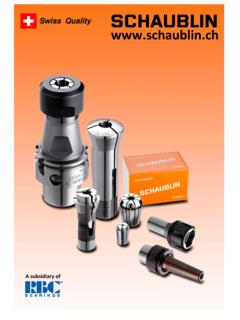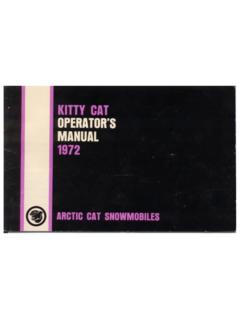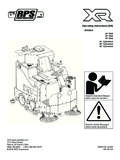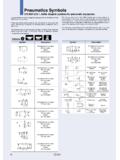Transcription of Safety Function: Sasfe Limited Speed and Safe …
1 Application Technique Safety Function: safe Limited Speed and safe maximum Speed Products: TLSZR-GD2 Guard Locking Switch/Guardmaster Safety Relay/ PowerFlex 70 Drive Safety Rating: PLd, Cat. 3 to EN ISO 2008 2 Rockwell Automation Publication Safety -AT086A-EN-P May 2013 Important User Information Solid-state equipment has operational characteristics differing from those of electromechanical equipment. Safety Guidelines for the Application, Installation and Maintenance of Solid-State Controls (publication available from your local Rockwell Automation sales office or online at ) describes some important differences between solid-state equipment and hard-wired electromechanical devices. Because of this difference, and also because of the wide variety of uses for solid-state equipment, all persons responsible for applying this equipment must satisfy themselves that each intended application of this equipment is acceptable.
2 In no event will Rockwell Automation, Inc. be responsible or liable for indirect or consequential damages resulting from the use or application of this equipment. The examples and diagrams in this manual are included solely for illustrative purposes. Because of the many variables and requirements associated with any particular installation, Rockwell Automation, Inc. cannot assume responsibility or liability for actual use based on the examples and diagrams. No patent liability is assumed by Rockwell Automation, Inc. with respect to use of information, circuits, equipment, or software described in this manual. Reproduction of the contents of this manual, in whole or in part, without written permission of Rockwell Automation, Inc., is prohibited. Throughout this manual, when necessary, we use notes to make you aware of Safety considerations.
3 WARNING: Identifies information about practices or circumstances that can cause an explosion in a hazardous environment, which may lead to personal injury or death, property damage, or economic loss. ATTENTION: Identifies information about practices or circumstances that can lead to personal injury or death, property damage, or economic loss. Attentions help you identify a hazard, avoid a hazard, and recognize the consequence. SHOCK HAZARD: Labels may be on or inside the equipment, for example, a drive or motor, to alert people that dangerous voltage may be present. BURN HAZARD: Labels may be on or inside the equipment, for example, a drive or motor, to alert people that surfaces may reach dangerous temperatures. IMPORTANT Identifies information that is critical for successful application and understanding of the product.
4 3 Rockwell Automation Publication Safety -AT086A-EN-P May 2013 General Safety Information Contact Rockwell Automation to find out more about our Safety risk assessment services. IMPORTANT This application example is for advanced users and assumes that you are trained and experienced in Safety system requirements. ATTENTION: Perform a risk assessment to make sure all task and hazard combinations have been identified and addressed. The risk assessment can require additional circuitry to reduce the risk to a tolerable level. Safety circuits must take into consideration Safety distance calculations, which are not part of the scope of this document. Table of Contents Introduction .. 4 Safety Function Realization: Risk Assessment .. 4 Safety Function .. 5 Safety Function Requirements.
5 5 Functional Safety Description .. 6 Bill of Material .. 7 Setup and Wiring .. 8 Configuration .. 10 Calculation of the Performance Level .. 14 Verification and Validation Plan .. 21 Additional Resources .. 22 4 Rockwell Automation Publication Safety -AT086A-EN-P May 2013 Introduction This Safety function application technique explains how to wire, configure, and integrate two 872C proximity sensors, a Guardmaster Guard Locking with Proximity Sensor Safety Relay (GSR GLP), a TLSZR-GD2 guard locking switch, two E-stops, a Guardmaster Dual Input (GSR DI) Safety relay, and a PowerFlex 70 Drive into a Safety system to provide safe , guarded access to a hazardous area only when the hazardous monitored motion is at safe Limited Speed or slower. Emergency stops are provided whenever the monitored Speed exceeds the safe maximum Speed or when either of two E-stops is pressed.
6 An emergency stop is also provided when safe Limited Speed has been requested, the gate is unlocked and open, and the monitored hazardous motion increases to exceed the configured safe Limited Speed . The GSR GLP relay monitors the 872C sensors and the TLSZR GD2 switch for faults in their state and sequence of operation. The GSR DI relay monitors the E-stops and the safe -Off function of the PowerFlex 70 drive for faults in their operational state or their circuits. The GSR GLP and GSR DI relays monitor their internal circuits for faults. Faults do not lead to the system failing to perform its Safety function on demand, which is de-energizing the hazardous motion. Once the Safety function has been performed, the system cannot be reset until the fault has been corrected. Safety Function Realization: Risk Assessment The required performance level is the result of a risk assessment and refers to the amount of the risk reduction to be carried out by the Safety -related parts of the control system.
7 Part of the risk reduction process is to determine the Safety functions of the machine. For the purposes of this application, the presumed Performance Level required (PLr), for each Safety Function, is Category 3, Performance Level d (Cat. 3, PLd). A Safety system that achieves Cat. 3, PLd, or higher, can be considered control reliable. From: Risk Assessment (ISO 12100) 1. Identification of Safety functions 2. Specification of characteristics of each function 3. Determination of required PL (PLr) for each Safety function To: Realization and PL Evaluation 5 Rockwell Automation Publication Safety -AT086A-EN-P May 2013 Safety Function This application includes four Safety functions. 1. Removal of power from the hazardous motion when either E-stop 1 or E-stop 2 is pressed. 2. Removal of power from the hazardous motion when the monitored hazardous motion exceeds the safe maximum Speed .
8 3. Removal of power from the hazardous motion when the gate is open and the monitored hazardous motion exceeds the safe Limited Speed . 4. Prevention of access to the hazardous area when hazardous motion is present. This system provides a Stop category 0 stop; power is removed and hazardous motion coasts to a stop. Safety Function Requirements During normal operation, access to an area containing hazardous motion is prevented by a guard-locked gate switch. The Speed of the hazardous motion is monitored. When the hazardous motion exceeds the safe maximum Speed (SMS), an emergency stop is performed. Sometimes qualified personnel need access to the area to perform some task while hazardous motion is present. In this instance, safe Limited Speed (SLS) is requested by pressing the Gate Unlock Request button.
9 The request sends a signal to the drive that controls the hazardous motion, instructing it to go to the specified safe Limited Speed . When the monitored hazardous motion has reached safe Limited Speed , the gate is unlocked to allow access. If the hazardous motion exceeds the safe Limited Speed while the door is open or unlocked, an emergency stop is performed. An emergency stop can be initiated by pressing either of two E-stop buttons. After an emergency stop, access to the hazardous area can be obtained by request. Faults at the door guard lock, proximity sensors, Safety relays, drive or wiring terminals are detected before the next Safety demand. The system cannot be restarted until all faults are corrected. safe Limited Speed Mode Max Speed =SL2 SLS=SL1 Unlock Request <SL1 t Speed 6 Rockwell Automation Publication Safety -AT086A-EN-P May 2013 The Safety function meets the requirements for Category 3, Performance Level d (Cat.)
10 3, PLd), per ISO 13849-1, and SIL3 per IEC 62061, and control reliable operation per ANSI Functional Safety Description In this application example, the access gate is locked during normal operation. Two inductive proximity sensors are mounted to detect the presence of Mark and Space features on a specifically designed target wheel . Mount the target wheel as close as possible to the relevant hazardous moving parts. The Guardmaster Safety Relay (GSR) GLP monitors the two proximity sensors and the output signal switching device (OSSD) outputs of the TLSZR-GD2 guard locking switch. The TLSZ-GD2 switch monitors itself for internal faults, lock status and gate actuation. When a fault is detected, with the gate unlocked and/or open, the TLSZR-GD2 switch turns off both of its OSSD outputs.
















